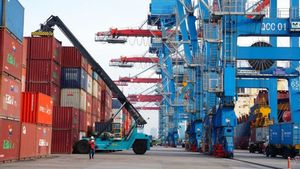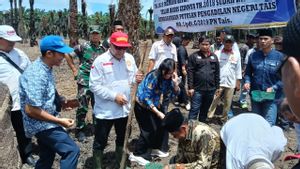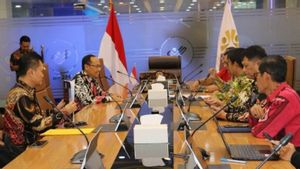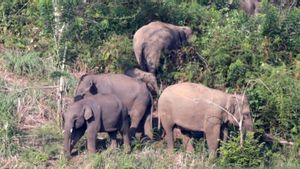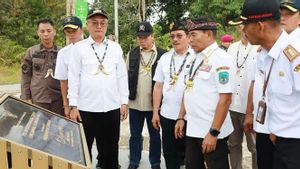JAKARTA - Forest and land fires (Karhutla) are still a challenge facing the Indonesian government. After the 2015 forest and land fires, the government has taken massive corrective steps that have effectively suppressed the forest and land fires in 2016-2018. However, the threat of forest and land fires is still high, as in 2019, making the government continue to make various breakthroughs.
"Entering 2020, the government will carry out a village-based prevention strategy, intensify efforts to control forest and land fires and strengthen preventive actions at the site level," said LHK Minister Siti Nurbaya as reported by the media, Wednesday (6/11).
In the presentation which was also conveyed to entrepreneurs during the 2019 KADIN National Coordination Meeting, Siti Nurbaya explained that for village-based prevention, there would be synergy between the KLHK and the Agency for the Assessment and Application of Technology (BPPT), the Ministry of Villages (Kemendes) and the Ministry of Agriculture (Kementan).
Among them are to inventory the villages prone to forest and land fires, improve the welfare of rural communities not only by relying on oil palm, developing the application of land clearing technology without burning (PLTB) and agricultural mechanization.
In addition, companies in the forestry and plantation sectors are required to carry out their obligations in preventing forest and land fires which have been regulated by regulations, and assist village communities around their areas to develop alternative economic businesses.
For budget support related to forest and land fires prevention, apart from support from the Central Government (APBN), it will also be strengthened through the Village Fund and Local Government (APBD, DBH-DR).
In a long history of forest and land fires, Indonesia has experienced several severe forest and land fires including 1994 (5.9 million ha), 1997-1998 (11.8 million ha), 2006 (3.8 million ha), and 2015 (2.6 million ha). million ha).
Indonesia succeeded in suppressing forest and land fires in 2016 (438.3 thousand ha) and 2017 (165.4 thousand ha), through corrective steps such as strengthening the forest and land fire control system, moratorium on peat permits, moratorium on oil palm permits, peat ecosystem management, and law enforcement. environment.
However, the challenge of forest and land fires increased again in 2018 (510.5 thousand ha) and 2019 (857.7 thousand ha up to September).
`` Even though compared to 2015 the fires that occurred in 2019 decreased by 67%, we must not be careless. Because 99% of forest and land fires are caused by humans, '' said Siti Nurbaya.
The strategy for handling forest and land fires is as directed by President Jokowi at the 2019 Dalkarhutla National Coordination Meeting, including priority for prevention, structuring of sustainable peatland ecosystem management, immediate extinguishing of emerging hotspots, and law enforcement for forest and land fire perpetrators.
For prevention, integrated patrols for forest and land fires prevention were conducted in 8 vulnerable provinces (North Sumatra, Riau, Jambi, South Sumatra, West Kalimantan, Central Kalimantan, East Kalimantan and South Kalimantan).
Integrated patrols are strengthened by independent patrols and routine patrols by Manggala Agni, Brigdalkarhut National Park / Balai KSDA / KPH. Patrols work in synergy with Joint Operation Teams (Local Government, Private, Community) in fire prone villages.
`` The villages covered by this program in 2019 are 1,461 villages with 415 Command Posts at the village level. We will continue to strengthen integrated patrols to prevent forest and land fires at the site level, '' said Siti Nurbaya.
Efforts are also being made to early detection through thermal CCTV cameras, use of drones, and hotspot monitoring through the Web Sipongi KLHK, LAPAN, BMKG, BNPB (also available in the form of an android application).
In addition, monitoring of forest and land fires vulnerability is carried out in peat areas, where data can be monitored hourly and provide alertness for field implementers.
KLHK has also developed SiMATAG-0.4m (Peat Groundwater Information System). The SiMATAG-0.4m was built by the Ministry of Environment and Forestry as an effort to monitor the success rate of the implementation of peatland ecosystem function restoration by collecting a database for monitoring groundwater levels (TMAT) and rainfall in concession areas and community lands.
"The database manages monitoring data from 10,331 TMATs spread throughout Indonesia and is updated continuously through a gadget application (mobile application based)," he explained.
The Ministry of Environment and Forestry also continues to carry out socialization efforts for alternative land preparation without burning (PLTB) through the use of land clearing residues for wood vinegar, compost and charcoal briquettes.
For law enforcement, until October 2019 legal proceedings had been carried out on 79 companies holding concessions involved in Karhutla. Throughout 2015-2019, KLHK has won environmental lawsuits of more than Rp. 19 trillion, most of which came from forest and land fires cases.
The English, Chinese, Japanese, Arabic, and French versions are automatically generated by the AI. So there may still be inaccuracies in translating, please always see Indonesian as our main language. (system supported by DigitalSiber.id)





